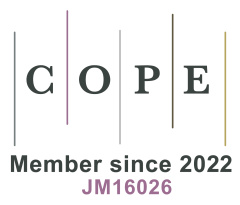Revolutionizing molecular and cellular biomechanics research: The impact of innovative English curriculum in biological sciences
Abstract
This study focuses on the crucial role of English curriculum construction in biological sciences for molecular and cellular biomechanics research. Taking a school’s biotechnology major as an example, it analyzes the existing problems in current English courses and teaching methods. By applying theories like spiral curriculum and constructivism, teaching materials and classroom methods are updated. The results show that this reform significantly improves non-native English speakers’ professional English abilities in the field of molecular and cellular biomechanics. Specifically, it promotes the development of scientific thinking and expression skills, which is expected to enhance international communication and collaboration in molecular and cellular biomechanics research, thus directly contributing to the progress of this research field in China.
References
1. Amano T, Ramírez-Castañeda V, Berdejo-Espinola V, et al. The manifold costs of being a non-native English speaker in science. PLOS Biology. 2023; 21(7): e3002184. doi: 10.1371/journal.pbio.3002184
2. Sun H. Development of a Specialized College English Learning Program for Biotechnology Students. Journal of Commercial Biotechnology. 2023.
3. Meher AK, Kumar EK, Gangwar A, et al. Review on Mechanobiological Analysis and Computational Study of Human Tissue (Soft and Hard) Using Machine Learning Techniques: A Mechanical Perspective. Archives of Computational Methods in Engineering. 2023; 31(2): 957-972. doi: 10.1007/s11831-023-10003-4
4. Biros C, Matthys L. Designing a hybrid course in english for biotechnology for health students in Grenoble Alpes university. Iceri 2019 Proceedings. 2019; 1: 1795-1802. doi: 10.21125/iceri.2019.0504
5. Tleuzhanova GK, Mekezhanova AB, Baigozhina ZhM. Metasubject Potential of Teaching English to Biology Students. Bulletin of the Karaganda University Pedagogy series. 2022; 108(4): 201-206. doi: 10.31489/2022ped4/201-206
6. Jiang X. Chinese Biology Teaching Assistants’ Perception of their English Proficiency: An Exploratory Case Study. The Qualitative Report; 2014. doi: 10.46743/2160-3715/2014.1226
7. Jelani M, Abd Aziz A, Hassan H. Challenges Faced by Students in Answering Biology Essay Questions in the English Language. Jurnal Pendidikan IPA Indonesia. 2023; 12(3): 343-354. doi: 10.15294/jpii.v12i3.42552
8. Pham TC, Tuyen TTT, Hung HCM. Students’ perception of the advantages and disadvantages of learning English for biology with native and non-native English-speaking teachers. Ho chi minh city open university journal of science-social sciences. 2018; 8(2): 3-13. doi: 10.46223/hcmcoujs.soci.en.8.2.278.2018
9. Wicaksono RS, Susilo H. Implementation of Problem Based Learning Combined with Think Pair Share in Enhancing Students’ Scientific Literacy and Communication Skill Through Teaching Biology in English Course Peerteaching. Journal of Physics: Conference Series. 2019; 1227(1): 012005. doi: 10.1088/1742-6596/1227/1/012005
10. El Ajraoui T. English for Biomedical Engineering: Higher School of Technical Education Students as a Case Study. European Scientific Journal ESJ. 2019; 15(14). doi: 10.19044/esj.2019.v15n14p1
11. Meyerhöffer N, Dreesmann DC. Let’s Talk Biology – Developing a Model for Incorporating English-Speaking Experts into the (Bilingual) Science Classroom. The American Biology Teacher. 2019; 81(3): 152-159. doi: 10.1525/abt.2019.81.3.152
12. Kakbaevna T, Eglambekovych K, Anna A, et al. Scientific and Methodological Bases of Creating Electronic Textbooks on Biology in the English language. Biosciences, Biotechnology Research Asia. 2015; 12(3): 2747-2756. doi: 10.13005/bbra/1957
13. Fernando P, Cooper R. Teaching strategies: Supporting EAL students in learning biology terminology. Teaching Science; 2017.
14. Jufri AW, Imam B, Wahab ADA, et al. Implementation of English for Biology Based on CLIL Student Handbook to Improve English Proficiency of Prospective Student Biology Teacher. Jurnal Penelitian Pendidikan IPA. 2023; 9(1): 346-349. doi: 10.29303/jppipa.v9i1.2437
15. Hermawan H. The analysis of biology students’ needs in English language learning. English Education and Applied Linguistics Journal (EEAL Journal). 2022; 5(1): 31-37. doi: 10.31980/eeal.v5i1.67
16. Ben P, Ma K. Biotechnological Approaches to Enhancing English Vocabulary Teaching Across Chinese and Western Cultures Using Bio Corpus Technology. Journal of Commercial Biotechnology. 2024.
17. Zadlo A, Cebula G, Mioduszewski B, et al. 142 Enhancing Resuscitation Education through a Spiral Curriculum at JUMC. Resuscitation. 2024; (S1): S71-S72. doi: 10.1016/S0300-9572(24)00453-2
18. Precellas LBC, Napil MC. Constructivist Learning Environment, Critical Thinking Motivation, Self-Directed Learning Readiness, a Structural Equation Model on Students’ Engagement. Asian Journal of Advanced Research and Reports. 2024; 18(11): 124-141. doi: 10.9734/ajarr/2024/v18i11781
19. Chen D, Wang Z. Research on VR Geography Teaching Mode Based on SOLO Classification Theory. New Explorations in Education and Teaching. 2024; 2(5). doi: 10.18686/neet.v2i5.4615
20. Asmoro SP, Suciati S, Prayitno BA. Empowering Scientific Thinking Skills of Students with Different Scientific Activity Types through Guided Inquiry. International Journal of Instruction. 2021; 14(1): 947-962. doi: 10.29333/iji.2021.14156a
21. Luu Quy K, Luu Ngoc Bao T. Perception, Attitude and Practice of English Presentation Skills by Students at the University of Danang-University of Foreign Language Studies, Vietnam. International Journal of English Language Studies. 2023; 5(2): 66-83. doi: 10.32996/ijels.2023.5.2.7
Copyright (c) 2025 Author(s)

This work is licensed under a Creative Commons Attribution 4.0 International License.
Copyright on all articles published in this journal is retained by the author(s), while the author(s) grant the publisher as the original publisher to publish the article.
Articles published in this journal are licensed under a Creative Commons Attribution 4.0 International, which means they can be shared, adapted and distributed provided that the original published version is cited.



 Submit a Paper
Submit a Paper
